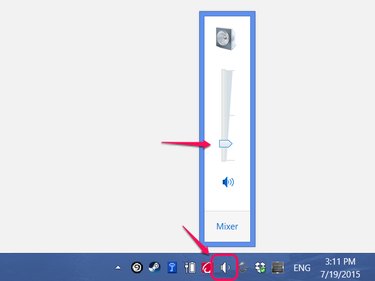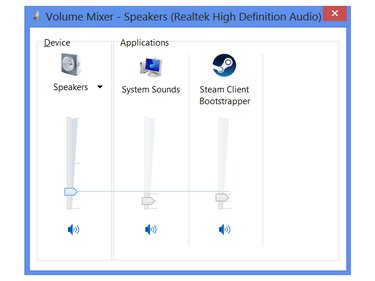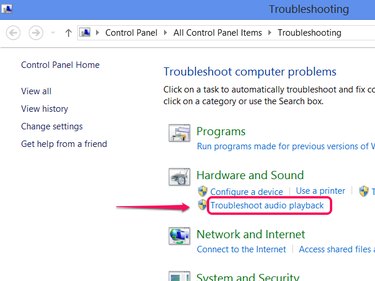First things first: if sound just stopped working on your computer out of the blue, save your work and reboot the computer. Windows 7 and 8 sometimes get stuck in a state in which the system thinks your sound hardware is already in use, preventing it from starting new audio, and rebooting solves the problem. Other first-tier troubleshooting steps include making sure your speakers are connected and turned on.
Set Volume Levels
Video of the Day

Just like a TV, Windows has a volume setting and a mute button. With the volume set too low or muted, you won't hear sound from any of your applications. Click the speaker icon on the taskbar (or in the hidden icon section) and drag the slider to change the volume level. The blue speaker icon beneath the slider toggles mute.
Video of the Day
Application-Specific Volume Levels

Even if you turn up the global volume level, you won't hear sound from an application if its individual volume is turned down or muted. Click Mixer beneath the volume slider to set the volume for each running application. The Device slider sets the maximum volume for all applications.
Speaker Volume
On laptops and all-in-one systems, the Windows volume setting doubles as the speaker volume. However, most desktop computers have external speakers with their own volume dials. Make sure you have your speakers turned up, as the Windows setting can't override the physical volume dial.
Set the Default Device

Right-click the speaker icon on the taskbar and choose Playback Devices to see other sound settings. On the Playback tab, make sure you have the correct audio device set as the default device. If not, select it and click Set Default. After changing the default device, close and reopen an application to redirect its sound to the selected device.
Device Levels

Some devices have detailed volume level options for separate speakers or channels. Click Properties and open the Levels tab to see these options, if your device offers them. If any of the levels are muted or set to 0, try turning them up to see if that solves your problem.
Install Sound Drivers
All pieces of computer hardware require drivers to operate. Without the correct driver for your sound hardware, you might hear low-quality sound or no sound at all. Drivers probably aren't the culprit if your sound suddenly cut out, but are a likely cause if your troubles began after installing new hardware. Install the newest drivers from your sound card manufacturer's website after replacing sound hardware.
Run the Troubleshooter

When other solutions don't help, try running the Windows audio troubleshooter. Search the Start screen or Start menu for Troubleshooting, open it and then click Troubleshoot Audio Playback. Click Next to begin and follow any suggestions Windows offers.